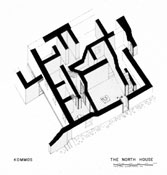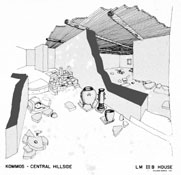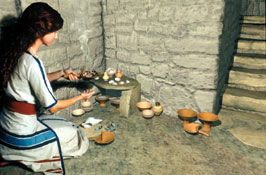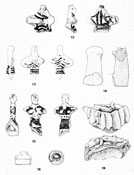 |

|
The North House |
|
| Central Hillside House Shrine The single large Minoan house on the Central Hillside had, in its final period, a simple shrine in its main room, with a small slab enclosure for a brazier burning charcoal (center, left), a tripod cooking pot (center right) and a jar. Between the latter two was found, standing as abandoned, a tall vessel with multiple handles called a “snake tube.” In its mouth was a conical cup and perched on its handles were molded clay birds, signs of the deity (see also below). |
|
| House X Shrine (Digital restoration by C. Dietrich) A second household shrine, also from the Postpalatial period, was discovered in House X in the Southern Area. On a simple slab table were found, abandoned, shells and small clay ritual jugs. On the floor there was also a large triton trumpet shell, often associated with Minoan ritual, as well as braziers and open flaring vessels perhaps intended to hold offerings. A delicately engraved sealing showing a bird-like goddess was discovered here as well. In the illustration a young girl from the modern town of Pitsidia models as participant. |
|
|
Lily Fresco
Found in the storeroom of House X in the Southern Area were these fragments of a splendid fresco scene depicting white lilies, a common Minoan symbol most likely of the beauty and fruitfulness of deity-imbued nature. Only rarely are such scenes found outside the Knossos area. |
|
| Maria Shaw with Olive/Grape Press Bed A major domestic feature discovered in the hilltop houses was this large slab with its projecting spout. It functioned as a press for grapes and/or olives, the liquid produced running out through the spout to fall into a container, most likely a pithos or an amphora. |
|
| Clay Figurines Small painted clay figurines such as these were often found in domestic contexts at Kommos. Usually they are of females, probably worshippers. The object on the lower right is the crown of a deity of which the remainder was not recovered. |
|
|
Loom Weights
Life in Minoan communities required families to provide as much as possible their own shelter, food, equipment, and other necessities. Clothing, for instance, was usually made in the home, weaving it being one of the major activities. Of the looms used, however, nothing remains, but the weights that kept the threads in tension on the looms have been discovered at many sites, especially in connection with houses. In the illustration are seven types of such “loomweights,” all of baked clay and many made in differing weights. Some hung from one group of threads, others from two. One (lower left) was pierced longitudinally. |
|
| Bull Rython This Middle Minoan clay vessel was made in the form of a bull’s head, and was decorated with vegetal and linear motifs in a light-on-dark technique. The bull played a special role in Crete, especially in the area of Knossos where apparently games involving bull-leaping took place. Also, there were clay, metal, and stone vessels (“rhyta”) that were for pouring libations, of which this was probably one. It was found in a house. |
|
| Snake Tube (left) and Detail of a bird perched on one of its handles Found in the hillside shrine described above was this “snake tube,” a tall vessel (left) with its open top closed by a cup filled with ashy clay. On each side were four handles, at least two of which had small clay birds, wings spread, perched on them (right). The exact function of such vessels, of which this is one of the earliest remains unknown; but they assuredly played a role in ritual, perhaps one that combined worship of the spirits of the earth (represented by the snake-like handles) and those of the sky (represented by the birds). |
|
|
|
|









